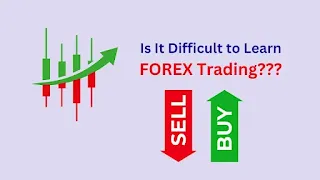The Big World of Money Exchange: Learning How to Trade Wisely
Imagine you have a bunch of your country's money, maybe rupees, and you want to travel to America. To buy things there, you need American money called dollars. The place where you can change your rupees for dollars (or any country's money for another) is called the Forex market. "Forex" is short for "Foreign Exchange." It's like a giant global market where people and big companies trade different currencies all the time.
Did you know that every single day, trillions and trillions of dollars' worth of currencies are traded in this market? That's so much money that it's hard even to imagine! The trading reports of April 2022 give you shocking data. The average daily trading volume was about $7.5 trillion! It’s just unimaginable for a normal person, right?
That's like having 75 followed by eleven zeros! Many people around the world try to make some money by buying one currency and selling another at the right time. This is called Forex trading.
Suggested articles for you:
Now, just like in any game, if you want to play well, you need to know some strategies. Strategy helps with forex trading in various ways. For example, it tells you when to buy or sell a currency. Here are five important strategies that many traders use. Even if you are in the 7th standard, you can understand these basic ideas!
1. Riding the Wave: Trend Trading
Have you ever seen the sea? These waves sometimes go very high and sometimes very low.. In the Forex market, the price of a currency can also go up or down for a while. This is called a trend. Trend trading is like being a surfer who catches a big wave and rides it as long as it goes in one direction.
How it works:
First, you look at the price chart of a currency pair (like rupees and dollars) to see if there is a clear direction. Is the price mostly going up? Or is it mostly going down?
If you see that the price is generally going up, you might decide to buy that currency. This is similar to betting that the price will continue to rise, allowing you to sell it later for a higher price.
If you see that the price is generally going down, you might decide to sell that currency. This is like betting that the price will keep going down so you can buy it back later at a lower price and make a profit.
Example: Imagine that for the past few weeks, the price of the American dollar has been slowly going up compared to the Indian rupee. If you are a trend trader, you might think this upward trend will continue, so you decide to buy dollars now, hoping to sell them later when they become even more expensive in terms of rupees.
Think about it: If you see many people are buying ice cream on a hot day, what might happen to the price of ice cream? It might go up because more people want it. Similarly, if more people are buying a currency, its price might go up.
Suggested for You
2. Playing in a Box: Range Trading
Sometimes, the price of a currency doesn't really go up or down much. It stays within a certain high and low price, like a ball bouncing between the top and bottom of a box. This is called a range. Range trading is like playing inside this box. You buy when the price is near the bottom of the box and sell when it's near the top.
How it works:
You need to identify a currency pair whose price has been staying within a specific range for some time. This means it doesn't go much higher than a certain price (the top of the box) and doesn't go much lower than another price (the bottom of the box).
When the price touches the bottom of the range, you might buy, expecting the price to go back up towards the top.
When the price reaches the top of the range, you might sell, expecting the price to come back down towards the bottom.
Example: Let's say the price of one British pound has been mostly staying between ₹100 and ₹102 for the last month. If you are a range trader, when the price drops to around ₹100, you might buy pounds. Then, when the price goes back up to around ₹102, you might sell them for a small profit.
Think about it: Imagine your favourite chocolate bar usually costs between ₹20 and ₹25. If you see it selling for ₹20, what might you think? It's a good deal, so you might buy it, hoping it will go back to its usual higher price.
3. Catching the Short Swings: Swing Trading
Whenever you buy a small or very quick price movement, that is called swing trading. It's a bit like when you catch the small waves of the ocean. These price movements usually last for a few days or weeks. Swing traders are in the business of extracting profits from such tiny swings.
How it works:
Swing traders look at charts for patterns that suggest the price might move up or down in the short term.
They might hold a trade open for a few days to a week, trying to capture that price swing.
Once they have made a small profit from the swing, they close their trade and look for the next opportunity.
Example: Suppose you see a pattern on a chart that suggests the price of the Australian dollar might go up against the Japanese yen in the next few days. As a swing trader, you might buy Australian dollars now and plan to sell them a few days later if the price goes up as you expected.
Think about it: Imagine you are playing a game of catch. Just like when you throw a ball to your friend. And he does the same thing by throwing it back to you in the same way. Swing trading is a bit like catching those short throws back and forth to make small gains.
4. Jumping on the Breakout: Breakout Trading
Sometimes, the price of a currency gets stuck in a range for a while, like water behind a dam. But then, suddenly, the price might break out of this range and move strongly in one direction. This is called a breakout. Breakout trading is about trying to catch this sudden move.
How it works:
You wait for the price of a currency pair to stay within a certain range for some time. This is like waiting for the water to build up behind the dam.
Once the price moves strongly above the top of the range (a breakout upwards) or strongly below the bottom of the range (a breakout downwards). At such times, you enter a trade with the expectation that the price will increase or decrease in exactly the same direction.
Example: Imagine the price of the Euro has been trading between $1.05 and $1.06 for several days. If suddenly the price jumps to $1.07 and stays above it, a breakout trader might buy Euros, hoping the price will keep going up.
Think about it: You are stretching a rubber band by pulling it very tightly. If you let it go, it will snap in one direction. You can compare this built-up pressure to a price breakout when it suddenly releases.
5. Earning Interest: Carry Trade
This strategy is a bit different. It's like putting your money in a bank that gives you good interest. In Forex, different countries have different interest rates for their money. In a carry trade, you borrow a currency with a low interest rate and use it to buy a currency with a high interest rate. Your profit comes from the difference in these interest rates.
How it works:
You need to find two currencies where one country has a much higher interest rate than the other.
You borrow the currency with the lower interest rate.
You use that borrowed money to buy the currency with the higher interest rate.
As long as you hold this position, you earn interest on the currency you bought and pay interest on the currency you borrowed. The goal is for the interest you earn to be more than the interest you pay.
Example: Let's say the interest rate in country A (currency X) is very low (like 0.5%), and the interest rate in country B (currency Y) is high (like 5%). In a carry trade, you would borrow currency X and use it to buy currency Y. You would earn 5% interest on currency Y and only pay 0.5% interest on currency X, making a profit of 4.5%.
Important note: This strategy can be risky because if the exchange rate between the two currencies moves against you, you could lose money even if you are earning interest.
A Word of Caution
Learning about these strategies is the first step. But just like learning the rules of a game doesn't make you a champion, understanding these trading strategies doesn't guarantee you will make money in Forex. The Forex market can be very unpredictable, and you can lose money if you are not careful. It's always a good idea to learn more, practice (often using fake money in a demo account), and understand the risks involved before you start trading with real money.
Think about it: If you are learning to ride a bicycle, would you start on a busy road right away? Probably not. You would start in a safe place and practice a lot before going into more challenging situations. Forex trading is similar.
Conclusion
The world of Forex trading is a vast and fascinating thing to explore. Understanding these top 5 basic strategies – Trend Trading, Range Trading, Swing Trading, Breakout Trading, and Carry Trade – can give you a good starting point to learn how people try to make money by trading currencies. Remember that each strategy has its own rules and risks. As you continue to learn, you will discover more about how this global money market works. Just like any skill, becoming a good trader takes time, patience, and a lot of learning!














